The Half-Spaces
This article will delve into an oft-neglected area in tactics theory: the half-spaces.
In our analyses we have often made reference to them. We are also frequently asked what the half-spaces are and what their purpose is and I want to devote myself to answering that question here. First we should categorize the half-spaces and then briefly discuss their characteristics.
Dividing the field into zones
The playing field is typically divided into several parts. There are many different approaches to this division. One method is to divide the field into the predetermined lines of the formation. There are usually either three or four horizontal lines or bands. In a 4-4-2 there are three bands and in a 4-1-4-1 there are four. Between the bands there is the “intermediate line space” or, the space between the lines. The same process can be applied to the field vertically.
It’s also possible to make simple divisions of the field. Most of these systems divide the width of the field into three parts; the two wings and the center. Louis van Gaal differs by cutting the field into 18 rectangles, 6 vertical by 3 horizontal, in which players have certain tasks and responsibilities.
The middle column here is a little wider and is still mainly divided into the middle and the wings. Depending on which part of the field the players are in and which of the four phases of the game the team is in (in possession, out of possession, defensive/offensive transition), certain players will have different tasks based on the four reference points of Arrigo Sacchi. Another alternative is to divide the field into pure geometric splits, e.g. 18 zones (3×6) of equal proportion to one another.
The “intermediate line space” of a team that sits deep will pop up in the ominous “Zone 14”, which is considered by many to be a crucial element of the game. Here’s a link to an article referencing facts and scientific studies on this.
Dividing the field horizontally
Personally, I am in favor of a division that is more focused on the tactical events, key strategic areas, and their respective game situations. Therefore I divide the field into three basic areas: the wings, half-spaces, and center.
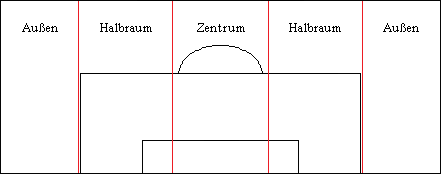
Alternative scheming in the horizontal; “outside/wing” – “halfspace” – “middle/centre” – “halfspace” – “outside/wing”. For English readers it should also be important that obviously “halfspace” is not a good word, but it’s not an invention but the translation of the word “Halbraum” which is established in Germany already for years by it’s elite coaches and the German FA.
Theoretically, you can make the wings (Außen) in the picture above even smaller, extend the half-spaces (Halbraum) and the middle (Zentrum), or divide the three zones differently by area; even a division into seven columns is possible. But, the center of course always refers to the middle. The center is – as in chess – usually seen as the main zone. Whoever controls the center, controls the game. One can easily explain why with a few examples.
The freedom of choice is greater in the middle of the field. There is no boundary created by the touchline. One has roughly eight basic directions from which the ball can be played (forward, backward, left, right, and four diagonal lines). On the wing there are only five directions (forward, backwards, square to the left or right, and two diagonal lines). This means that the space to work with is limited and the precision of vertical passes must be higher.
This is not the case in the middle. A team that bases their play around establishing a greater presence in the center will have many more choices and thus be more dynamic. The opponent must also not only defend the two wings, but the middle and both wings, because from the center of the field either are directly playable.
On the other hand, the center is usually heavily occupied, so there is generally less time to make decisions. In addition, more space must be surveyed (360°) by the passer. Therefore, teammates and opponents can easily be overlooked. The lack of time on the ball, coupled with the challenge of lacking space, does not generally occur on the wings, where the opponent’s shape is usually less compact than in the middle. Furthermore, the winger need only survey 180° to see the whole field. Also, turnovers in the wide zones are less problematic than in the center. As was mentioned in the example of zone 14, the path from the center to the goal is the shortest. Losing the ball on defense there causes an immediate threat to one’s own goal.
But why should there be an additional division of the wing-center-wing into the half-spaces?
The goal-orientation of football
The answer is simply a logical association with the game of football. Football is about scoring goals. Whether you’re a romantic or pragmatist, fan or coach, tactician, strategist or slob: everyone ultimately wants the ball to go into the net.
The goal is located in the center of the field; both teams’ shapes change for the purpose of ball-oriented defending, reducing space, and zonal marking, depending on the position of the ball. If the ball is on the wing, then both teams will look different than when the ball is in a central position.
The “half-space” exists in this sense for analysis. Looking at the shifting movements of two teams, one not only notices the differences between the ball being on the wing or in the center, but also in a position in between the two; the half-space.
For the sake of explanation, imagine a team in a 4-4-2 is defending against a 2-5-3 team in their buildup phase. The six of the offensive team drops slightly and faces up vertically and centrally between the central defenders. The 4-4-2 team is in their “normal” positions. They must not move and this is the basic shape of the offense and defense. Both teams will now play towards a goal; that of the defending team. One team on offense, one on defense.
In the next scene, the ball has landed on the wing. The defending 4-4-2 team shifts the near winger over to establish access and their shape changes. The full-back moves up to cover and the two central defenders are deeper, similar to the crescent shape we see in the midfield. The movement, the circumstances, and the strategic options are different. Naturally, the team plays from here towards the goal, but the spaces are now much tighter and difficult to break down.
In the last scene, we’ll look at what happens when the ball is in the half-space. For this purpose, the six (or a set disengaged central defender) stands in the half-space. Again, both teams change shape. We can therefore assume that the half-spaces are ideally classified as a separate space, because the resulting movement of both teams creates strategic differences.
As we move between these three zones, the position of the ball only changes slightly. The movements are intense, but there is no fundamentally new shape. Thus, it should be ruled out that a further vertical dimension is needed in the layout; only the passing options and taktikpsychologischen aspects (earlier shots around the penalty area, etc.) are different.
The diagonality of the half-spaces
Adding the half-spaces between the center and wings results in a different view of the strategic and tactical peculiarities of the game: the fields of view are one aspect. In a central position, with both teams standing right in front of the goal, the fields of view are both vertical. For positions in the half-spaces, however, the fields of view are not vertical, but diagonal. A player in the half-space has as many options as the central player, but doesn’t have to turn away from the center and play to the side, instead maintaining a diagonal, goal-facing view of the field in his passing game.
The field of view
The field of view or visual field is composed of the foveal and peripheral vision. In contrast to the foveal vision, in which the eye’s sight line is aligned exactly with a targeted object to take advantage of the maximum central vision, peripheral vision provides rough, blurred, and distorted visual impressions outside of a solid fixation point. In principle, the object in question is “seen by” the peripheral vision. The sight field has a horizontal binocular (binocular) expansion of about 180-200 °; and vertically about 130 °.
The field can be increased significantly through moving the eye muscles (range of vision). In this way, a range of approximately 270 ° can be covered solely horizontally. The glance field refers to the area that a standing man can grasp without moving his feet. With unrestricted movement of the torso, 360 ° can be detected visually in the horizontal.
The view of the goal and the positioning of the half-spaces creates a special effect. If we imagine a player can look effectively up to 50 meters forward from the center of the field (because after all, the field ends at some point), he can focus his attention on the goal or the spaces near the goal.
But if a player looks diagonally from the half-space towards goal (or from the spaces near the goal or the wing), he sees a lot more space and thus has, in theory, not only more options, but also significantly more space to work with.
At the same time, the amount of space he doesn’t see is smaller. Because the player is in the half-space and (usually) has a diagonal field of view towards the goal or to the open field, he has less distance from the sideline and is facing away from it. Thus, there is little danger that he will be pressed from behind or come under great pressure.
The range of the diagonal pass works against the opponent’s movements much better than banal verticality. This is because the ball can go further and faster in addition to the nature of the more stable dynamics when the ball arrives at its destination. This also allows for a greater range from the diagonal passing game.
In addition, the half-space is not so close to the touchline that it can be used against the player, as is often the case with a winger. The half-space is thus the ideal intersection of “I have enough space” and “what I can’t see doesn’t matter anyway”.
This of course is not to be taken literally or overvalued. It is merely a clarification of the basic theoretical things in an ideal situation, which may not always happen in the game. One must therefore consider and evaluate these aspects depending on the situation; against some teams the wings may be the best means of attack.
Speaking of the attack, let’s look at the advantages of the half-spaces on offense. In essence, they provide a positive Dynamik for combination play and extra space.
The passing game
Due to the goal-oriented nature of football and the factor of the cover shadows, diagonal passes are an important alternative to vertical and horizontal passes.
Vertical passes are the fastest way to gain space. On the other hand, the view of the field is restricted for the pass receiver since he usually has his back to the opponent’s goal and can’t see what’s going on behind him. Also, if the receiver has an opponent on his back, he can’t turn towards goal and must play the ball back.
Horizontal passes primarily serve to shift play or switch sides and can also help escape pressure. But lateral passes don’t directly gain any space, so there is no pressure placed on the opponent’s goal.
A vertical or a horizontal pass can at most cause only a simple change of direction in the game, making the opponent’s movements less complex. For a square pass or a vertical pass, the opponent needs only move in the direction of the ball. In essence, either pass direction only results in a new and promising situation if the opposing team has a bad shape or the passes cause a change in direction. In a series of square passes from one side of the field to the other, the ball will pass through various valuable areas, but when it comes out the other side it will have the same theoretical starting point.
The same holds true for vertical passes, although they cause more danger because the vertical movement is (especially back to back) more difficult for the opponent to handle and they can get behind the defense for a direct chance. In general, there are exceptions to the “simplicity” of both passes in extreme zones like the penalty area, where they can lead directly to shots.
A diagonal pass, however, both directly gains space as well as shifts play, which means that the pass receiver has a good field of view and a safer opportunity to pass. The risk of a lack of pressure on the opponent from horizontal passes and the limited viewing angle from vertical passes are circumvented by the diagonal pass. Thus, diagonal passes combine the advantages of the vertical and horizontal passes, while neutralizing the respective drawbacks.
A diagonal pass causes the opponent to make a more complex movement than is the case from horizontal and vertical passes. The opponent must adjust both their direction and their height, not just one or the other. In most cases this requires the opposing players to behave somewhat asymmetrically. The individual defenders within the group must move slightly differently, which can lead to more errors.
What does this have to do specifically with the half-spaces? On the one hand, the goal-focus in the half-spaces often automatically results in diagonality. On the other hand, where the diagonal passes are played from is crucial. From the middle of the field a diagonal pass leads away from the goal; from the wings it heads towards goal, but from an isolated zone to a player who must be turned away from goal to accept the pass.
Again, the half-space combines two positive aspects and makes the disadvantages rudimentary. Diagonal passes go from the half-space either into the strategically important center or to the wing but with the ball aligned with the view of the field and directed towards goal. These advantages of the diagonality in the half-space and its underlying diagonal character are among the key features of this zone.
Furthermore, diagonal passes have an expansive character; to play a successful horizontal ball over 30 meters is as difficult as playing a vertical pass 30 meters, because the opponent can block the channels quickly. A diagonal pass can “cut” these vertical and horizontal lines, which gives a long ball a greater chance to arrive safely – in other words: the result is the opportunity to play a successful long pass. Another nice side effect: a diagonal through ball from the half-space into the middle simultaneously gains horizontal and vertical space.
Another factor of diagonality does not relate to passes, but to the opponent’s movements.
The trigonometry of the half-spaces
A vertical or horizontal movement is usually shorter than a diagonal motion with a similar effect; this is, of course, not absolute, but provides context. A team that is in a 4-2-4 and sets up their four strikers in front of the opponent’s four defenders and behind the four opposing midfielders, allows the opponent easy access to their strikers. But, if the forward line is more narrow, the two outside strikers/wingers will be in an intermediate position.
They are between their normal position and the center forward position and they are also between four rather than two opponents. While this sounds like it will cause unnecessary pressure and facilitate the opponent’s defensive work, the opposite is true. If the winger goes into this intermediate position, the opponent has to go a long way to cover them.
Let’s look at a sample calculation (yay, mathematics):
We have two lines of four; the midfield and the defense are ten meters from each other. Between them, at an imaginary limit of five meters, are the four opposition strikers. They are exactly in a vertical line with the midfielders and defenders of the opponent. Thus, each striker has five meters distance between two opponents and ten meters horizontally between their teammates.
For simplicity’s sake, assume that the backward run is equally as quick as the forward run.
We push the wingers into the middle and keep the full-backs of the opponent outside. We also assume that the wingers are indented exactly five meters. Now the full-back and the winger of the opposing team does not need to move five meters, but about seven (7.0710678); So about two more meters are required to generate pressure on the winger who will have a little more space and time to react.
But again the question pops up: where does the half-space have its special advantage over other areas. In a central intermediate position a player would be diverted from the goal if the opponent moves up; also, by indenting their wide players to cover the central players the opponents block the middle well and direct passes to the wings.
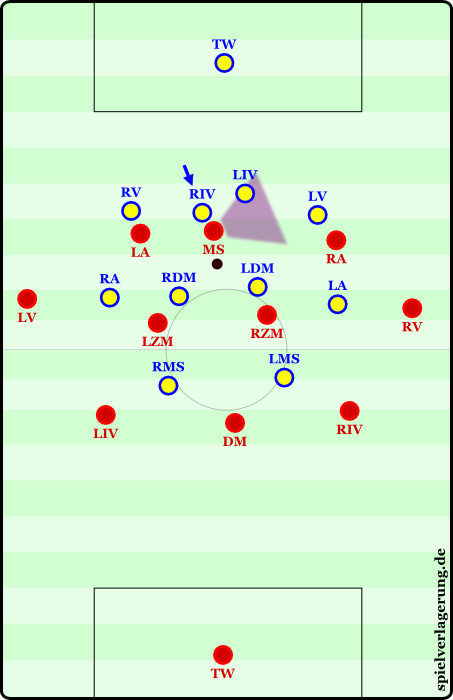
Pass through the midfield to the center forward. Not only can the opponent stay relatively simple with their shape, but the defender also has a simpler protection when pushing up to take the attacker, can guide the receiver to the side and has a shorter path in his approach.
There, the defensive unit shifts again and establishes their basic formation. On the wings, one can not take an intermediate position in this respect. In the half-space, however, a central player is ideally drawn out or at least put in a bind without allowing the defender to force the attacker’s movement. As in the previous situation, it does opens the wings, but to a lesser extent, making them easier to handle; which is just as effective.
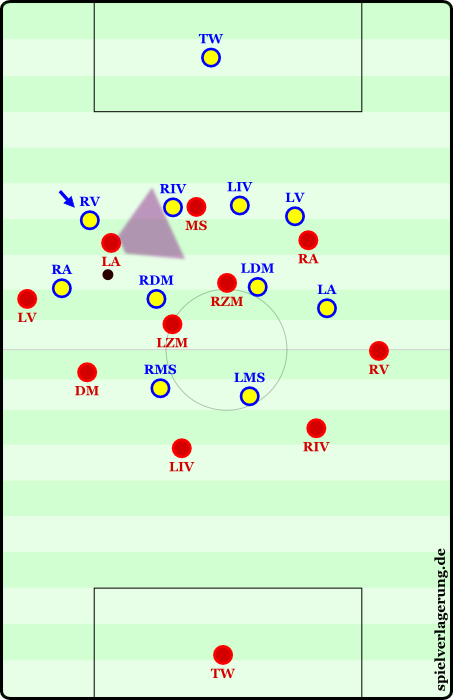
Here the field of view is directed at attacking the middle, the full-back has a slightly longer distance to move and the opponent is somewhat unorganized.
In addition, the center is not occupied and is therefore free to play with Dynamik. Direct layoffs from the intermediate position in the half-space can provoke the closest central player to move out of position; particularly a short twist or “opening” back towards him. This means that the pass receiver is positioned with his field of view in the direction of the central player or is turning to suggest so, causing them to be lured into pressing. A player can then more easily put in a through ball and, thanks to the strategic nature of the middle, have options in every direction; Atletico Madrid and Red Bull Salzburg under Schmidt often tried to take advantage of these schemes.
Against back three variants this looks a bit different; in certain circumstances there is a possible central intermediate position where a narrow back three effectively opens up two channels.
This positioning causes the opponent other tactical problems. FC Barcelona played from 2008-09 to 2010-11 with a front three that deliberately focused on the half-spaces and the “intermediate positions” in those zones. This was especially the case in their two successful Champions League seasons. Henry and Messi (or Eto’o) and Villa and Pedro moved from a wide position into the opposing channels. The three of them were able to bind four players while the wings were used by the advancing full-backs.
To this end, there is also a small example. Suppose the opponent played in a 4-4-1-1 defensively. Because of the positioning of the strikers and full-backs they were often forced into a 6-2-2 formation (instead of a 4-4-2) on defense, in which Xavi and Iniesta often played into the defensive and offensive half-spaces. Their ball circulation caused the two sixes to have to run a lot and because of Busquets they had one more man in midfield.
This was associated with the variable positions taken up by the two eights, the short passing game of Barcelona, and the flexible movements of the wingers and full-backs; alternating between sometimes being lower, sometimes higher, sometimes narrower and sometimes wider. In the 2010-11 season, it was of course the constant dropping off from the deep play-making number nine (Messi) which provided an additional player in the second third and in the half-spaces.
The fear of the opposing central defenders to take on Messi – which Guardiola mentioned – was created by the depth provided by the indented wingers. They tied up two to four players as they threatened to break through the channels between the full-back and center back when the opposition defenders pushed forward to take on Messi.
This is also important: the binding of the player to the zones and shapes produced this effect and must therefore always be seen in context. These special features of the half-space occupation are extremely interesting, as Barcelona were able to show under Guardiola. This variable and often simultaneous occupation of the two half-spaces on offense, especially with Messi and Iniesta, leads us to another interesting tactical aspect.
Half-space switches and shifting play between the half-spaces
Under the aegis of Guardiola, Messi and Iniesta often occupied the half-spaces in the gaps in the opponent’s midfield, one level further forward than Villa and Pedro. In their passing play they often either let the ball bounce in an open area behind them or rotated into the open space in front of them. As a result of Messi and Iniesta positioning themselves in the midfield half-spaces, they had Busquets and Xavi as central passing options. Because of this, Barcelona could quickly switch to the half-spaces on the attack, which was a hugely effective strategy in their possession style:
A pass into the half-space channel pulled the opposing team into that zone. The key players here mostly tried to establish access and because the winger was bound by the Barcelona full-back, the second central player had to cover the open space. From a back-pass into the midfield, Xavi had two options for an incisive pass: the pass through the central channels or into the channel in the half-space, where Messi was. Xavi could also play the ball square to Busquets to get a direct vertical pass to Messi.
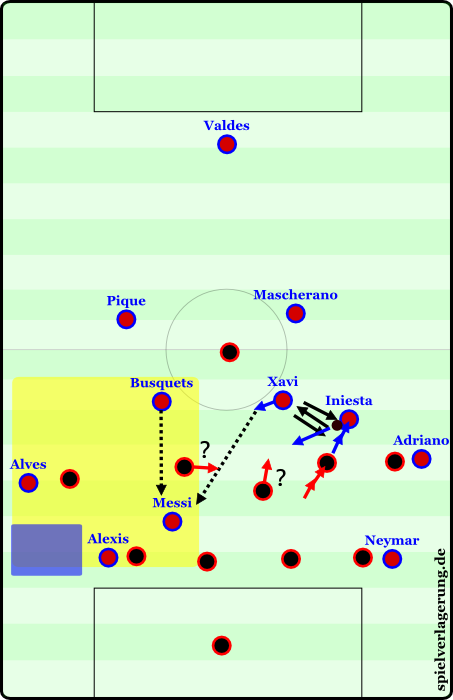
Iniestas walk in the half-space can be used as a pass combination, as well for opening up holes and moving the opposing defense. In both cases the half-space is a very interesting area to make things as complex as possible for the opponent as well as opening up the channels and passing lanes.
Again, the use of the half-space is crucial because it binds the central player. On a pass to the wing the opponent’s block remains compact. On a central pass, the opponent’s two central midfielders move together and the retreat to their previous positions is simple. The half-space, however, has an opening effect on the middle, which makes the half-space a strategically opportunistic component.
Theoretically, one could even argue that the half-space is superior to the middle. From the half-space, both the middle and the wing are options. But from the midfield there are only the two identical half-spaces, which both have the same end product and a clear path to goal. Direct shifts from one half-space to the other are particularly effective. Bayern Munich were already making use of this under Heynckes and have continued to do so under Guardiola (especially in the game against City) with Ribery and Robben.
A shift from one half-space to the other offers several different perspectives and is the ideal intersection of a great number of strategic factors. The ball does not traverse only one zone (ie from midfield to the half-space or from the half-space to the near wing), which wouldn’t require the opposing defense to move much; or three zones (from the half-space to the far wing or vice versa) or more (wing to wing), which would give the opponent too much time to adjust to be truly effective. The time component of the pass length on the opponent’s movement is not adversely affected by direct half-space shifts. The passer and the receiver are close enough to be able to play a flat or at least chipped pass, which is not difficult to handle or play with precision. Furthermore, the opponent must move quickly or gaps will form that can be used for vertical passes to the strikers.
The switch across two zones seems to be the best option. In the middle, however, the only option for crossing two zones horizontally is to play to the wings, making it less valuable. From the wings, the middle can be played, but there are drawbacks in other strategic aspects and it would be practically difficult due to the shifting of the opponent and the boundary of the touchline. Nevertheless, passes on the wings are used, even by Bayern or Barcelona, so that the opponent will be pulled to the wings and allow the attackers to move into the midfield and attack the retreating defense with a lot of freedom. Often the winger will then move into the half-space and offer themselves up for a pass.
Thus, the half-space shifts are more effective, from a strategic point of view, because they move the ball from one space to another space with a similar freedom of choice and function. One might even argue that a direct shift from one wing to the other is no longer practical (due to the technical complexity, isolating the wing, pressure on the wings), the half-space on the far wing, however, is still within the realm of feasibility.
The middle, however, does not offer the opportunity to go into a third zone. Also, to make a direct backward shift from half-space to half space (from the wing to wing) is likely to be difficult. A direct switched ball from the touchline is also difficult to play due to the nature of the wing and the more limited space. At the same time, a backwards shift provides rather interesting tactical, psychological, and strategic opportunities that can cause the opponent, especially a ball-oriented or man-oriented team, huge problems; generally, backwards shifts are a rarely mentioned, underestimated and underused aspect in football.
Also, this feature of the half-space in terms of shifting play is higher valued both qualitatively and quantitatively. The same is the case with swapping positions and overloads in the half-spaces.
Switching positions, overloads and half-space features
The half-spaces have the benefits of being close to the other zones and offering more choices to the attacker; one can therefore combine with players from the wings and the middle. While the same is true of the middle, it doesn’t offer the same synergy. If the players all slide to the middle then it lacks the potential of shifting the ball over two zones to the flanks. Meaning: if you have the ball then you usually can’t leave the wings empty, otherwise it will be too tight in the middle. Usually both wingers are providing width and hugging the touchline, making them disappear as combination partners; this means (depending on the desired players on the wing) having two to four fewer combination options. In the half-spaces this is different.
The half-space is close to the wing. The nearest wide player is thus quite playable and not too far away. The players who are normally in the center and in the far half-space can also indent and operate closer to the half-space where the ball is without neglecting their zone. The far wing player can also indent more towards the center and take up a position in the half-space; something Jürgen Klopp often does with his far full-back. Now there is an interesting interaction between the time component and the opponents’ lack of space.
In the time component, it is the length of the shifted ball that supports the indenting; even if the winger indents more (and thus covers the far half-space player potentially indenting further), he is still playable on the wing. Once the ball-carrier sends off a switched ball, he can already be in motion and run to the wing. Once the long ball arrives, he is usually already close to the touchline. For an indirect shift with short passes between several players this works easily. As mentioned, if the ball is already lost, the indented wide player can indent further and immediately take up his proper position for ball-oriented shifting, thereby being less prone to counter attacks. Bayern took advantage of this with their false full-backs this past season; they let the actual width givers indent more in the first third, in order to open these spaces and overload the half-spaces and were good at counter-attacking in the strategically important central areas while being less protected on the wings.
The second interaction, with the opponent’s lack of space, is also easy to explain: If the ball is in the middle, then the opposing team is relatively stable there and mostly occupies the middle and the half-spaces; the wingers in a 4-4-2, for example, usually hover near the wing spaces because the time factor also affects the supporting shift. Until the ball comes to the side, that supposedly open side may be barred shut. But if the ball is in the half-space or on the wing, the far player needs to indent really far or they’ll have trouble maintaining the horizontal compactness needed. The wingers must also not stand very wide but next to the opponent’s formation in order to give width. This will enable them to indent and cover; allowing them to quickly provide better local compactness in the half-spaces while in possession.
Overloads of players from the strategically least important zone, the wings – especially in the protection of their own attacks – are thus possible; which brings us to the false full-backs of Bayern Munich again. The half-spaces can be quickly overloaded by players indenting a few meters and players swapping positions is no problem due to the high number of players in the three zones (half-space, middle, half-space) and the short distances between them. These position switches, the brief abandoning of the wing, and the general features of the half-space also provide other positive effects, which aren’t possible in the middle or on the wings.
Thus, the half-spaces also have a very collective nature; the possibility of rapid and targeted diagonal combinations, the harmony and feedback effects of the fields of view, and the way many players can combine ensures variety and constructiveness in a team’s play. This is interesting and important not only in the defensive and offensive game, but also in transition.
The half-spaces in transition
Anyone who deals with the Spanish and South American football school will often come across the phrase that the defense and offense are not separate but “one”. Therefore, the opportunities and benefits of half-spaces for the team in possession have been presented, but the importance of the half-space also applies to the defense.
Basically, the division of defense and attack is only helpful to directly consider the strategic aspects of certain situations and phases. What is behind this unity of defense and offense, is the mixing of many aspects that directly affect the other phase of the game. So a stable, intelligent, high-scale, and well-secured possession game supports the defense; a good press and counterpress also supports a decisive offense. The half-spaces have a special character in this regard.
If one plays very half-space oriented in possession, moving frequently from half-space to half-space and holding on the ball a long time within them, they not only have some offensive advantages but allow for the integration of some interesting pressing options on turnovers. For example, it’s possible that the far half-spaces are quickly filled and covered by the indenting of the far winger. The player in the half-space can go aggressively into the middle, pressure the opponent there and win back the ball or guide him towards the wing. The opponent must then either play around the block or counter over the zone where the ball just was and a relatively compact shape now stands. Likewise, counterpressing traps are possible, which are generated from the previous occupation of the half-spaces, making it easy to block the middle.
When transitioning from defense to offense the process is similar. A team that dominates the half-spaces in their defensive phase can either isolate the middle, where they will have a lot of access or guide the opponent to the wings. Then it is possible to go beyond the half-spaces, partly to open space (for example, passing the enemy on the wings, opening its half-spaces and then counterattacking there) and then use the half-space to create options. One can seek passes from the “heap”, i.e. the group around the ball and more easily and freely rotate to give a little bit more resistance to counterpressing. From the half-spaces one can play to the wing, move the game into the middle, or switch the ball to the far half-space.
In addition, most teams are fanned out wide when they are in possession: The width-giving effect of the wing is no longer needed in a direct counterattack as the half-space can provide it. The opponent has only a few players and more space to defend, so one can sufficiently pull the opposition apart across the half-spaces with less width in their attacking play; all without losing nearby passing options and Dynamik. At the same time this effectively gives the opponent space out wide, therefore a very narrow counterattack, e.g. the teams of Roger Schmidt, are still promising. Even for Schmidt, taking the center and the half-spaces plays a key role in understanding the threat of their counterattack.
But even if it is not used vertically, the half-space has a positive effective on transitions. Gladbach under Favre paired ball-oriented shifting with their tight, position-oriented coverage (both were at their peak in Favre’s second season) and always had a good occupation of the half-spaces and a collective narrowness in offensive transition. They could then either move forward with rapid one-touch combinations, like Reus and his offensive partners, or move away from the opponents’ counterpressing by playing backwards and build play forward with a deep, stable possession; Neustadter, Dante, and ter Stegen were natural players for this system. The halfspaces offer not only ideal connections to different horizontal, but vertical zones as well.
In a way, the half-spaces are a “connection zone” under the umbrella of the other various zones. One could see the middle as more of an “organization zone” while the wings are suited to breakthroughs. In theory, a division of the different characteristics of the zones that takes into consideration certain play styles (ball circulation method of defense, etc) is an interesting article for the future . . .
But first … let’s look at the reason why, among other things, the half-spaces have these characteristics and special tactical significance.
The special characteristics of the half-spaces in tactics history
The half-spaces have a fundamental strategic nature, which is reflected in their different consequences, interactions, and properties. However, the half-space derives its own character not just from these basic aspects but from tactical reasons.
One often has a small advantage in this zone against the most commonly used formations. The frequency of certain formations – and hence the positive tactical effects of half-spaces – are historical. Formations are ultimately, after all, only arrangements designed to meet a certain objective within a manager’s game philosophy. From different cultures and traditions, similar processes and formations evolved that are often synonymous with a particular country or playing style. Ultimately, formations are only heuristics, which intend to simplify a way of playing according to a specific philosophy handed down by the coach in training.
Formations are also created on the drawing board as an attempt at arranging the players, giving them a linear character. There are no circular formations or arbitrary distributions on the field, but clear structures in lines or at the most three triangles, which are mostly also organized in lines and merely used as a way to get things set up.
These two aspects – the nature of creating formations and the cultural characteristics in football – in combination with the previously mentioned way of categorizing the “middle” and “wings” ensures a very unique, specific character in the half-spaces. In short: because players were/are never really planned to be in the half-spaces in the design of formations they can cause unpleasant effects in the shifting and combination options for the opponent; many teams move their central players a little towards the wing, others have turned to man-oriented play on the wings or – very often, especially in England – the wingers do not move towards the center of the field.
In all of these scenarios, the half-spaces are extremely effective and valuable. Because the half-spaces have historically never really been considered (excluding managers like Ernst Happel), they are often particularly effective and fatally surprising to opponents. So, for a long time, certain aspects of the usual, boring formations and standard movements have always been prone in the half-spaces. The horizontally unkompakte and generally symmetrical 4-4-2 of the 90s and 2000s is a prime example, whether in the buildup (spaces next to the passive strikers) or in the offensive game (widened gaps in the half-spaces). This was also due to the standard tactics like isolated wingers and their man-orienting. With a better shape and positioning, these formation problems can be fixed, but the vulnerabilities often remain and certain formations just have special characteristics that can be taken advantage of in their classical interpretation. The motto rings true: the ball runs faster.
Then there are the tactical and strategic aspects of the half-spaces and why they are effective against standard formations; the pass angles and gaps are generally easier to break with diagonal play and this effect is enhanced because of the wing and central orientation of opposing formations.
Imagine a team that is defending in a wide 4-4-2. Because they are wide, the half-spaces are open (their central players are in the middle and their wingers are on the wings). The attacking team moves two players into the half-space in a vertical line; one in the offensive half-space in midfield and the other into the attacking team’s own defensive half-space. Neither the six or the striker of the defending team will be able to cope with covering these players or their shifting movements. If the defending striker takes on his opponent he will concede space in midfield, harm the compactness of the formation and have problems establishing access. If the opponent was on the wing, he could at least be guided away and isolated from his teammates and if he was central the striker could more easily establish access. Furthermore, in the shift forward, the striker is usually at the same level and can’t protect the middle very well. In today’s space-oriented football, these problems are rare but have been seen. The English Premier League says hello. All of these circumstances beg the question:
Conclusion: Is the half-space better than the middle?
Out of sheer enthusiasm, it may seem like the half-spaces are not the second-but the most important area from a strategic perspective. Although the center has numerous benefits and is simply the closest zone to the goal, there are many similarities between the half-space and center in terms of advantages. Furthermore, the half-spaces are complemented with more variability: From the center you can play on two similar things, from the half-space two different zones, e.g. even the middle. There is also the following effect; to play from the half-space into the middle is, due to the synergy effects (the shifting of the opponents and the momentary opening of spaces for direct passes into the forwards), more effective than playing from the middle into the half-space or trying to overload within the middle two zones.
Then there is the natural diagonal character of the half-space. Central fields of view are vertical and the combination play requires you to divert yourself somewhat from the goal. In the half-space, the basic options and the eight directions of movement remain, but the field of view is directed towards goal. Also the practical negotiating of two zones and the long-range shifted ball is more effective from the half-space than the wing. In the middle there are two sides to which the ball can move two zones and in the half-space there is only one. However, in the half-space there is the potential to shift the ball over three zones to the other half-space, which is probably the most optimal location to switch play – from wing to wing the ball must travel so fast that it becomes almost impossible to control.
All in all, the discussion here is already too technical. The fact is that the half-spaces are rarely mentioned in the public media, although they belong to the standard vocabulary of Jürgen Klopp in his game analysis and Josep Guardiola explicitly coaches them when training positional play and is strategically important . This article aims to give a broad overview of the strategic aspects of the half-spaces even though we are just scratching the surface here; individual tactical aspects and dribbling options or even passing options (such as how the half-space affects the potential for through balls) as well as the tactical processes for the defending the half-space are all topics for a future article.
Our new author at Spielverlagerung.com, AO has, incidentally, also written tactic theoretical articles on the half-spaces that are here and here find.
Note: SV-reader Burrinho4 wrote in this and this tweet two interesting aspects, as well as TheSoulcollector in this comment . TW colleague then asked in a private chat, if the half-space is static / playing field dependent or dynamic / opponent dependent. My answer to him and in some ways, Burrinho and TSc, is that the half-space is dynamic, but depends on the situation and dynamics. That is also the reason why ball-oriented shifting and compactness work (internally referred to as the concept of “Strategieraumkongestion”). For me there is also the effective field, the playable, the played, the potential and the actual; in which the half-spaces, their position and texture vary. But that is for another article, as well as one about separating zones for training and strategy. Regarding the latter I have found here a worthwhile article from our SV-mate Marco Henseling.
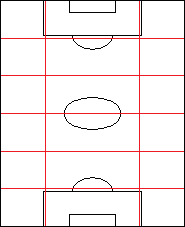
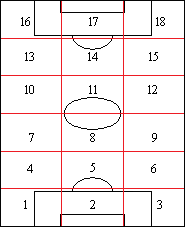
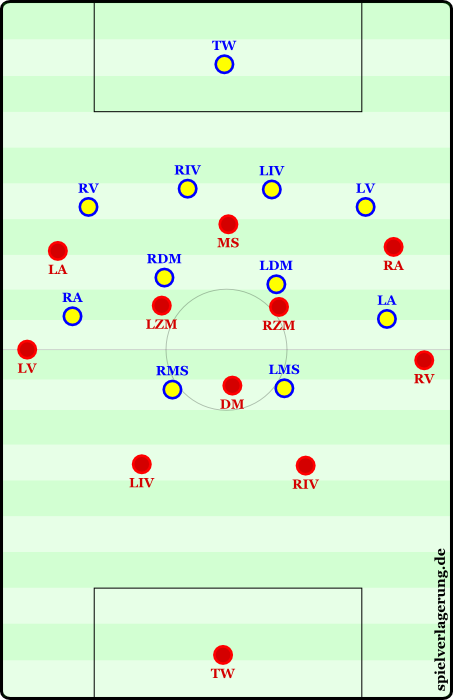
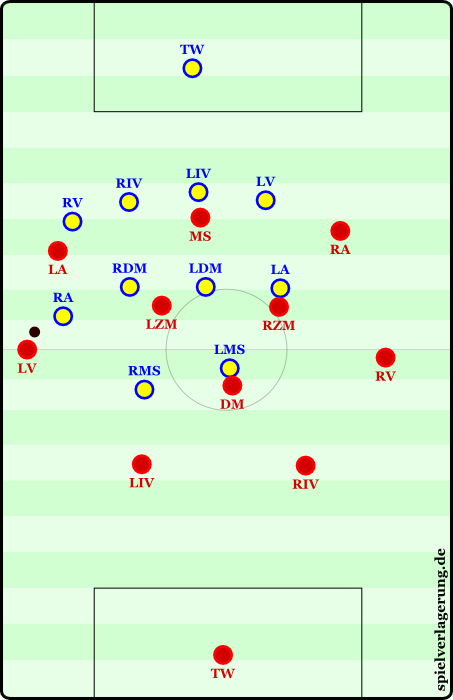
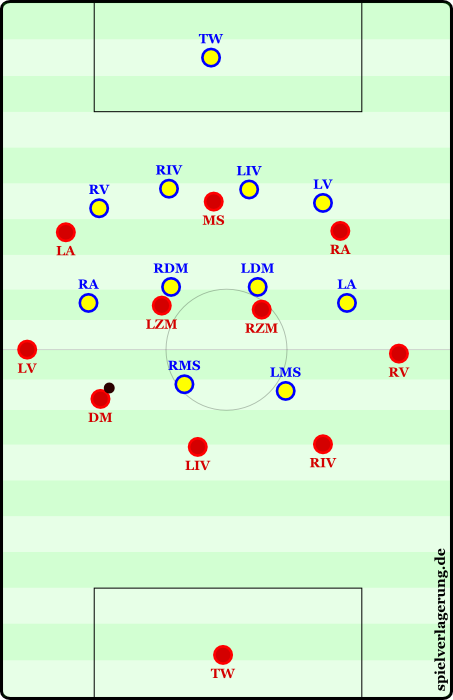
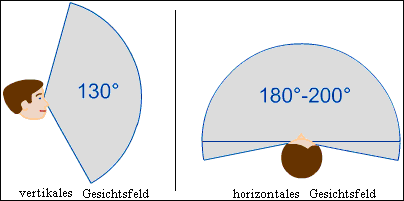
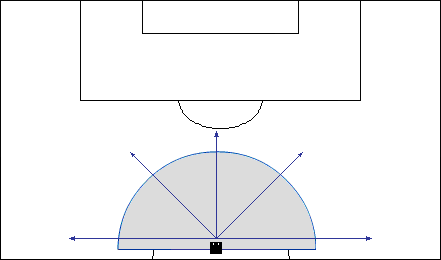
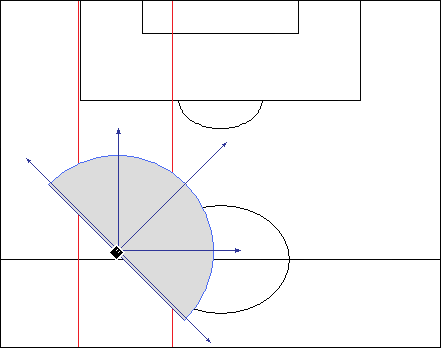
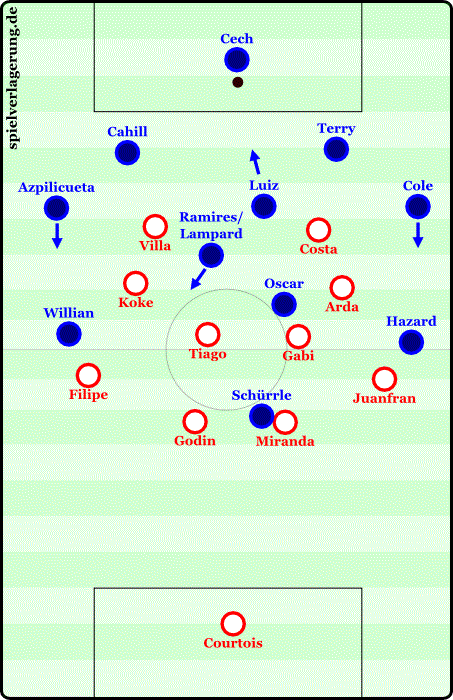
12 Kommentare Alle anzeigen
Raul November 2, 2017 um 5:38 pm
Great article, really nice
Bill Owens October 31, 2017 um 2:47 pm
Your articles bring a deeper level of insight–that of a chess-master–to the sport; completely changed the way I watch a match. Thank you.
Robbie January 23, 2016 um 10:27 am
Light years ahead. Excellent writing and graphics.
FootballCoach January 12, 2016 um 2:04 am
Good article. Must mention that the use of ‘basic’ formations and rigid wingers in the EPL are rare. Coaches have been utilising half-space combinations for more than a decade now. Those claiming Klopp will revolutionise the premier league forget that teams have evolved past rigid philosophies into dynamic, energetic and intelligent systems, throughout the league.
pedro santos November 15, 2015 um 12:35 am
This is a monster article… So glad to learn about this topic, with this wonderfull piece of iinteligence. Regards.
razaard June 12, 2015 um 11:40 am
I was curious about the backward shifts. Is it switching sides but going back (vertically speaking), like a backwards diagonal long pass? What are the hidden advantages of doing that? Arent you giving a lot of time for the defense to regroup when you do that?
cameron April 20, 2015 um 12:15 pm
Unbelievable article i learnt so much thank you.
Gaz A.F April 11, 2015 um 7:40 pm
Could you please help to explain what you mean by backwards shifts? Thanks.
AA September 26, 2014 um 9:39 am
Thank you very much for this! It’s very helpful for young coaches
Honoris September 24, 2014 um 10:47 pm
Put the translator on the blog
lucho September 24, 2014 um 7:32 am
nice article,learned a lot.what does the two “eights” and two “sixes” mean? i can only asscociate with the number 6 and number 8 position,but why we have two “sixes/eights”.looking forward your reply,fans in China.
Toc September 30, 2014 um 12:03 am
6 = DM (defensive midfielder)
8 = CM (central midfielder)
See http://en.wikipedia.org/wiki/Squad_number_%28association_football%29